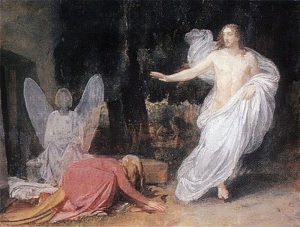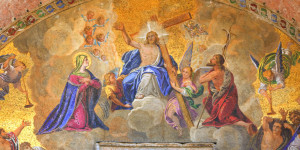Thoughts on Sunday’s Lessons for March 31, 2024 (Easter Sunday B)

The Appearance of Christ to Mary Magdalene after the Resurrection (c.1833), painting by Alexander Ivanov (1806-1858). Russian Museum, Saint Petersburg, Russia. (Click image to enlarge.)
First Reading or Alternate Second Reading: Acts 10:34-43
Christ is risen indeed! Alleluia! On Easter we celebrate Jesus’ victory over death through resurrection with alleluias and shouts of joy. In this reading from Acts, Luke’s story of the early church, Peter is visiting the home of the Roman Centurion Cornelius, who is considering becoming a Christian. Peter has just had a vision in which God told him that he should join the Roman family at table. No food is now to be considered unclean, a signal from God that salvation through Jesus’ life, death on the cross and resurrection is meant for everyone, not just Jewish Christians. God’s Good News in the Gospel shows no partiality, Peter tells Cornelius’ family. Forgiveness of sin through God’s saving grace is available to every nation, to Jew and Gentile alike: Jesus is Lord of all.
Alternate First Reading: Isaiah 25:6-9
The Prophet Isaiah imagines a sumptuous feast, a table loaded with rich food and fine wine, set out for all God’s people as a celebration of victory over death. Isaiah foresaw this as a national feast in the context of Israel’s dream of return from exile. It echoes through the ages for us as an image of God’s saving grace through Jesus. “Christ our Passover is sacrificed for us. Therefore let us keep the feast.” Amid the joy of the Resurrection and Easter Day, this affirmation that we repeat at Eucharist resonates for us as we praise God in gladness and rejoice in God’s salvation.
Psalm: Psalm 118:1-2, 14-24
This hymn of exultation in God’s goodness and mercy may have originally served as a processional hymn as the congregation came up the steps surrounding the ancient Temple in Jerusalem, singing out their gladness. Celebrating the people’s triumph as God saved them from slavery in Egypt with a mighty hand at the first Passover, it is filled with both joy and gratitude. We, too, are overjoyed at our salvation. We are delighted at our victory over death. We are grateful for God’s goodness and mercy. As with ancient Israel, God has heard our prayers, laying a new cornerstone for a just world. This is the day that the Lord has made: Let us rejoice and be glad!
Second Reading: 1 Corinthians 15:1-11
Near the end of Paul’s first long letter to the Christians of Corinth, he offers thoughts that serve well for our contemplation on Easter Sunday. Paul points to the central place of the Resurrection in Christian belief: Christ died for our sins, was buried, was raised on the third day and seen by the Apostles and by hundreds of followers. Everyone who saw the risen Christ, he writes – including Paul himself, forgiven despite his unfitness as a former persecutor – now proclaims to the whole world that God’s saving grace comes to us through the crucifixion and the resurrection.
Gospel: John 20:1-18
Like four witnesses discussing a memorable event, each of the four Evangelists tells the story of the first Easter morning in a slightly different way. John’s Gospel gives particular weight to Mary Magdalene, describing her in beautiful, tender verses as the one who discovered the empty tomb and then, after the excited men had come and left, remained there and thus became the first person to witness the risen Christ. In a narrative similar to other Gospel accounts of the risen Christ’s mysterious appearances, Mary did not recognize Jesus until he called her name. Then she became the one sent to proclaim the good news of his resurrection to the rest.
Alternate Gospel: Mark 16:1-8
Mark, the earliest of the Gospels, tells of the events of Easter morning in brisk, concise language, as is the style of Mark. The sun has risen, and three grieving women get up early to take spices to the tomb to anoint Jesus’ beloved body. When they arrive, worrying about who will move the heavy stone that bars the door, they find to their amazement that it has already been rolled away! A young man dressed in white tells them, “He has been raised; he is not here. … he is going ahead of you to Galilee; there you will see him, just as he told you.” It’s not surprising that they were terrified: They ran away and told no one. And there the original version of Mark’s Gospel ends without another word, leaving us to wonder what comes next.


